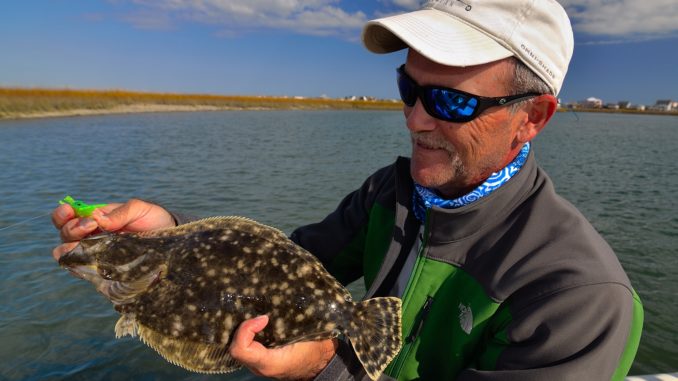
Big push inshore from wintering flounder fills smallish, shallow estuary.
Within feet of the state line, the northern end of the Grand Strand harbors a unique estuary with local and worldly significance. On a grand scale, Walter Maxwell’s 1,780-pound tiger shark — caught from a Cherry Grove pier in 1964 — remains untouched after almost 50 years, and is the only all-tackle world record from South Carolina waters. But light-tackle anglers recognize this area for an entirely different reason as April arrives. The two-lane boat ramp on the north end of 53rd Avenue in Cherry Grove gets more than its fair share of traffic, and for good reason. April means flounder around these parts, as Cherry Grove’s pocket-sized estuary fills up with hungry flounder moving in from the ocean through Hog Inlet when the rest of the region’s fishing barometer remains cold.
The Cherry Grove region has only 1,000 acres of shallow marsh between the mainland and the narrow barrier island that’s full of houses and high-rise hotels — and only 10 percent of that marsh has fishable depths for anglers with small boats. But this shallow estuary supports a tremendous invasion of flounder early in the spring when warm days become a regular happenstance.
Capt. Keith Logan of Feeding Frenzy Charters begins his spring charter season in Cherry Grove’s tepid waters. According to Logan, the regionally-unique locale is the hottest place around.
“The shallow water and protection from the wind allow the water to warm quicker than others,” said Logan (843-907-0064). “It’s shallow in there; the water will be five degrees warmer than the ICW and Little River Inlet.”
The bottom of Cherry Grove’s shallow estuary is covered with dark-colored sand and mud. On low tide, inhabitable water is restricted to the main channel and a few choice tributaries. Yet, these fish will pour into these estuaries as soon as the water temperature climbs into the mid- to upper 60s.
“Some flounder will be caught in cooler water, but 68 degrees is the key temperature to watch for and it’s when the fish start to bite well,” Logan said.
Capt. Mark Dickson of Shallow Minded Fishing Charters also participates in the spring flounder run in Cherry Grove — and in a big way.
“It’s a pretty unique place that produces a lot of fish,” said Dickson (843-458-3055). “Bring dozens of mud minnows, (because) plenty of flounder will be in there to eat them up.”
Flounder move into Cherry Grove’s estuary to feed and prepare for spawning, but they don’t all come in at once, even though it sometimes seems that with the huge numbers of fish available in spring.
“They move in from their offshore wintering grounds,” he said. “It’s mostly small fish at first, but the fish progressively get bigger as it warms up.”
As flounder arrive, they pile into the estuary’s waters, looking for a familiar place to set up for their spring feast, ambushing passing bait. While not too much of a surprise because they sport a low stature, flounder have evolved to blend in with the pluff mud and dark sand. The estuary is made of mostly shallow flats and marshland drained by a few confined channels and the main creek channel.
Dickson prefers to fish Cherry Grove on the lower end of the tide when the waters pack flounder into the deeper reaches of the sound.
“A lot of Cherry Grove is shallow and in low water, the fish will have few places to go,” he said. “Creek mouths collect fish on the falling tide in holes with six to eight feet of water.”
Dickson drops his Power-Pole and works the deep water slowly, fan-casting around. If he doesn’t get a bite in a dozen casts or so, he drifts down to the next hole and repeats the procedure.
Years of experience have taught Dickson that flounder will not move much during periods of steady current flow and will be packed together in small groups. But as soon as the current subsides to low tide, Dickson expects flounder to scatter out, looking for bait in a wide variety of places. The current packs flounder in small groups, usually against an undulation or slope along the bottom.
As the water begins to flow back into the estuary and pick up speed, Dickson will shift his position to catch the flounder as they change stance.
“As the tide begins to rise, the fish will move out of the holes and move up into the shallower places nearby,” he said.
Dickson will fish shallow places adjacent to deeper areas through a couple of hours into the rising tide. Logan also prefers to fish when the waters rise toward the high end of the tide.
“I like the two hours before and after the high tide in Cherry Grove,” he said. “The sun-baked mud flats heat up the water quickly. The top of the bars are good too.”
The solar-heated water on top of the mud and sandy flats attract any baitfish and crustaceans in the area, and flounder will take advantage of these unique places.
Typically, baitfish either swim with the current or get washed downstream by the strong currents. As a result, flounder orient facing into the current, anticipating meals gliding along with the tide. Logan uses a natural presentation of bait or lures that flounder will recognize and have no issues seeing.
“Cast upstream and work back towards the boat, bouncing along bottom and working very slow,” he said.
Logan and Dickson use a combination of live and artificial lures. Mullet minnows and peanut menhaden won’t be along until May, leaving tough-natured mud minnows as the staple live-bait option.
“We use minnow traps to catch mud minnows this time of year,” Dickson said, “but most bait shops will have minnows available in April.”
When the flounder bite hits its normal April stage, Logan said that a dozen live minnows will not last too long. He recommends bringing a few extra dozen minnows or a few packs of scented soft plastics as a backup.
“Flounder with a hearty appetite can be prolific this time of year. Never arrive without plenty of bait options,” Logan said.
For flounder, both Dickson and Logan prefer Gulp! shrimp and swimming mullet in white or new penny. While a 1/4–ounce jighead is generally preferred for Gulp! baits under these conditions, Logan employs small, white bucktail jigs tipped with Gulp! curlytails. The added hair gives these baits a realistic appearance and provide a real mouthful for flounder.
When using live bait, Dickson uses a Carolina rig with a ½- to 1-ounce weight and a No. 2, short-shanked 5180 Series Owner Hook.
DESTINATION INFORMATION
HOW TO GET THERE/WHERE TO GO: Cherry Grove’s marshes are easily-accessible from the public boat ramp at the north end of 53rd Avenue in Cherry Grove Beach. From US 17 at the Atlantic Intracoastal Waterway, turn onto Sea Mountain Highway and continue towards the ocean until the road runs into Ocean Drive. Turn left and proceed to 53rd Avenue. The boat ramp is at the end of the street, adjacent to the sound. Flounder will associate with the deeper channels and holes in the estuary. Fish deeper spots in the mouth of creeks and sandbars in the same immediate vicinity. All small or large channels will hold fish, as well as nearby shallows.
WHEN TO GO: While some small flounder winter in Cherry Grove’s estuary, most flounder migrate in from the ocean through Hog Inlet when water temperatures rise into the mid-to upper 60s, with 68 degrees a key temperature break. April 1 through May offers the best flounder action.
BEST BAITS/TECHNIQUES: Live mud minnows are the staple live-bait choice during the spring flounder run in Cherry Grove, but any live minnow, including mullet minnows, peanut menhaden and small croakers will produce. Bring lots of bait. Use small Carolina rigs with 1/2- to 1-ounce egg sinkers to get the baits to the bottom and a No. 2 5180 Series Owner Hook. Artificial lures will fare well, with scented soft plastics like Gulp! shrimp and swimming mullet in white and new penny fished on 1/8- to 1/4-ounce jigheads or bucktails. Fan-cast to deep holes and adjacent areas, casting upstream and working baits or lures slowly downstream. Baits can also be drifted or trolled downstream in the current at very slow speeds. Cherry Grove is littered with boat docks; fish the ones close to deeper water.
GUIDES/FISHING INFO: Capt. Mark Dickson, Shallow Minded Inshore Charters, 843-458-3055 or www.fishmyrtlebeach.com; Capt. Keith Logan, Feeding Frenzy Charters, 843-907-0064 or www.northmyrtlebeachfishingcharters.com; Fish-On Outfitters (843-249-2600). See also Guides & Charters in Classifieds.
ACCOMMODATION: Cherry Grove’s Public Information Portal, www.cherrygrovesc.info; Myrtle Beach Area Convention and Visitors Bureau, www.mbchamber.com; South Carolina Association of Visitors Bureaus, www.discoversouthcarolina.com.
MAPS: Navionics, www.navionics.com, 800-848-5896; 800-423-9026; Maps Unique, www.mapsunique.com, 910-458-9923.

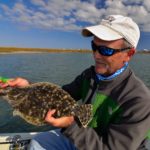
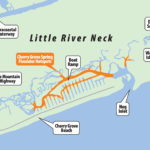
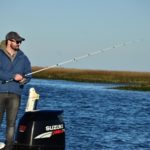
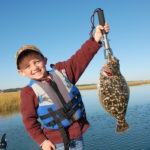




Be the first to comment